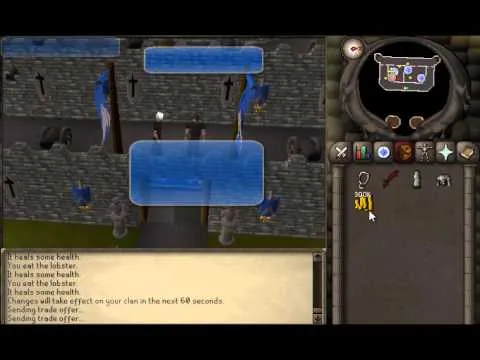Your cart is empty
Understanding the GE Trade Limit in OSRS

The Grand Exchange (GE) in Old School RuneScape (OSRS) serves as a centralized marketplace where players can buy and sell items efficiently. Established to streamline the trading process, it allows users to place orders for items they wish to purchase or sell without the need for direct interaction with other players. This system not only facilitates trade but also enhances the gameplay experience by providing a convenient way to manage in-game economies. Understanding the GE and its associated trade limits is essential for players looking to optimize their trading strategies.
Trade limits in the Grand Exchange are designed to maintain balance within the game’s economy and prevent inflation. Each player is subject to specific restrictions on the amount of items they can buy or sell over a given time frame. These limits vary based on the item’s nature and its overall demand within the game. For instance, high-demand items like rare weapons or armor pieces may have lower trade limits compared to more common items such as food or potions.
Players can only buy or sell a maximum of 15,000 coins worth of items every four hours. This means that if you purchase an item worth 5,000 coins, you cannot buy any other items until the cooldown period has elapsed, regardless of the item’s value. Additionally, players are restricted to a maximum of 100 items of any single type per transaction. This makes it crucial for players to strategize their purchases and sales effectively, especially when dealing with high-value items.
Trade limits also apply to item prices, which can fluctuate based on supply and demand. The GE utilizes a dynamic pricing system that monitors item trends, ensuring that prices reflect current market conditions. Players should keep an eye on price changes to avoid overpaying or underselling their items. Understanding how trade limits function can significantly enhance a player’s trading tactics, allowing them to maximize profits while adhering to the game’s regulations.
In summary, the GE trade limits serve as a mechanism to promote fair trading and economic stability within OSRS. By familiarizing themselves with these limits, players can better navigate the marketplace, ensuring their trading activities remain profitable and efficient.
How Trade Limits are Determined
In Old School RuneScape (OSRS), trade limits can seem a bit perplexing, but they are designed to maintain a balanced economy and prevent real-world trading fraud. Essentially, these limits are set based on a few key factors:
- Item Rarity: The more rare an item is, the higher its trade limit will generally be. This is to prevent players from trading vast sums for items that are hard to come by.
- Market Value: The current market value of items, influenced by player demand and availability, plays a significant role. If items are in high demand, their trade limits will adjust accordingly.
- Player Activity: The activity level of players trading certain items can also influence limits. If a specific item sees a surge in trading, its limit may be recalibrated to ensure fair trading practices.
- Game Updates: Jagex, the developer of OSRS, regularly updates the game. This includes changes to how trade limits are determined, often in response to economic fluctuations within the game.
It’s important to note that these limits can change, so keeping an eye on the game updates and community discussions can help you stay informed about current trading conditions.
Daily Trade Limit: What You Need to Know
Every player in OSRS has a daily trade limit, which is essentially the maximum amount of value in items that can be traded within a 24-hour period. Understanding this limit is crucial for anyone looking to engage in the game’s economy effectively. Here’s what you should know:
- Base Limit: The standard daily trade limit starts at 2 million GP (Gold Pieces) for most players. This means that you can trade items that cumulatively add up to this value every day.
- Increasing Your Limit: Players can increase their trade limit by achieving certain milestones, such as reaching higher levels in specific skills or gaining more quest points. For example, players with higher skills may find their trade limits going up to 10 million GP or more.
- Trading with Friends: If you’re trading with friends, keep in mind that the limit applies to the total value traded. So, if you trade various items that exceed your limit over the day, you won’t be able to trade again until the limit resets.
- Reset Time: The daily trade limit resets at midnight UTC. This means you can strategize your trades to maximize your trading potential each day.
Understanding your daily trade limit can help you plan your trades better, ensuring you make the most of your time in the game and avoid unnecessary complications!
Strategies for Managing Your Trade Limits
Managing your trade limits in Old School RuneScape (OSRS) can be a bit tricky, but with the right strategies, you can maximize your trading efficiency. Here are some practical tips to help you navigate the trade limit system:
- Know Your Limits: Familiarize yourself with the specific trade limits for different items. This way, you can plan your trades accordingly and avoid hitting the cap unexpectedly.
- Time Your Trades: If you find yourself close to your limit, consider waiting for the next reset. Trade limits reset every 4 hours, so timing your trades can make a big difference.
- Diversify Your Trades: Instead of focusing solely on high-value items, spread your trading across various items. This approach can help you manage your limits more effectively and reduce the risk of hitting a cap on any single item.
- Use the Grand Exchange Efficiently: Utilize the Grand Exchange interface to monitor price fluctuations and place buy/sell offers strategically. This can help you avoid unnecessary trades that would push you near your limit.
- Collaborate with Friends: If you’re part of a clan or have friends in-game, consider pooling resources. Trade items among yourselves to bypass individual limits while still benefiting from each other’s inventory.
By implementing these strategies, you can make the most out of your trading experience in OSRS while staying within the confines of the trade limit system.
Impact of Trade Limits on the Economy
The trade limits in OSRS have a significant impact on the game’s economy. Understanding these effects can give players insights into the market dynamics and help them make better trading decisions. Here’s how trade limits influence the economy:
| Aspect | Impact |
|---|---|
| Market Stability | Trade limits help prevent price manipulation. By restricting the volume of high-demand items that players can trade, the game maintains a more stable market. |
| Supply and Demand | Limits can create artificial scarcity for certain items. When players cannot trade freely, the supply decreases, potentially driving prices up. |
| Player Behavior | Players may change their trading strategies, leading to variations in demand for items. This shift can cause fluctuations in item prices and overall market trends. |
| New Player Accessibility | By controlling the trade flow, new players might find it easier to access items at reasonable prices, as veteran players can’t monopolize trades as effectively. |
In conclusion, trade limits play a crucial role in shaping the economy of OSRS. By understanding these impacts, players can better navigate the market and make informed trading decisions.
Frequently Asked Questions about GE Trade Limits
When it comes to the Grand Exchange (GE) trade limits in Old School RuneScape (OSRS), players often have questions. Here’s a rundown of the most frequently asked questions to help you better understand how these limits work.
- What are GE trade limits?
GE trade limits are restrictions on how much of a particular item you can buy or sell in a certain timeframe. These limits are designed to prevent market manipulation and ensure a balanced economy. - How are trade limits determined?
Trade limits are influenced by several factors, including the item’s demand, its rarity, and its average trading volume in the market. Generally, more popular items have lower limits to maintain balance. - What happens when I reach my trade limit?
Once you hit the trade limit for an item, you won’t be able to buy or sell that item until the limit resets. This usually happens after a 4-hour period. - Can I bypass trade limits?
No, trade limits are strictly enforced by the game to ensure fairness. Attempting to bypass them can lead to penalties. - How can I find out the current trade limits?
You can check the current trade limits of items directly in the Grand Exchange interface, or by using third-party tools and websites that track GE prices and limits.
Understanding these questions can help you navigate the Grand Exchange more effectively and avoid any unnecessary frustrations!
Conclusion: Navigating Trade Limits Effectively
In conclusion, understanding the GE trade limits in OSRS is crucial for any player looking to maximize their trading efficiency. The trade limits are not just arbitrary restrictions; they serve a purpose in maintaining the game’s economy. Here are some key takeaways for navigating these limits effectively:
- Keep Track of Your Trades: Regularly monitor your trades to ensure you’re not hitting limits unexpectedly.
- Plan Your Purchases: If you know an item has a low trade limit, plan your buying strategy accordingly to avoid delays.
- Utilize Time Wisely: Use the 4-hour reset time to your advantage by trading different items or optimizing your inventory.
- Stay Informed: Keep an eye on market trends and item values to make informed trading decisions.
By understanding and adapting to these trade limits, you can enhance your trading experience and make the most out of your time in the game. Happy trading!
